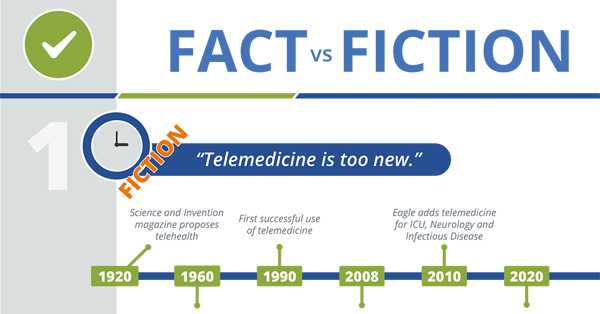In this blog series, we’re discussing our efficient process for implementation of telemed services. Previously, in the second installment, Implementing Real-Time Telemedicine Begins, we had moved into the weekly implementation discussions. In this post, we turn our attention to the Mock Go-Live sessions.
As a client site, you have been working with the Eagle Operations team to get your telemed services program through the implementation process. Workflows are complete; your remote deployment technology is in place and initial telemedicine technology training complete; EMR training is done; and secured texting set-up is good to go. What’s next? Now, you’re ready for Mock Go-Live sessions that emulate the entire telemedicine consultation process.
Typically a week or so before an actual program go-live, Eagle will work carefully with the implementation team to set up and schedule multiple (typically two to four) Mock Go-Live sessions between the on-the-ground nurses, providers and other clinical and operations staff. They usually last 30 to 45 minutes in duration. Designed to test the workflow in action as well as verify all the technology, call algorithms, and communication processes, these Mock Go-Live sessions provide everyone―from Eagle to the hospital―the opportunity to see all the pieces in action for telemed services. More importantly, it provides an open forum for questions on both sides. The goal is to expose as much of the onsite staff as possible to the workflow and allow them to get used to the technology. ALL questions are GOOD questions here.
Mock Go-Live sessions for each hospital are custom designed based on the telemedicine specialty provided and types of patients typically seen at the facility. As part of the process, we create a Mock Go-Live “script”. We encourage as much interaction with your staff as possible during these sessions to build a baseline understanding of all elements of the program. This includes utilization of a “dummy” patient to add a real-time face to the telemedicine consultation process. Eagle suggests nursing staff, physicians, and key administrators all be involved in at least one session to see the workflow in action and have the ability to interact with our staff.
Telemedicine and Healthcare – What’s Fact and What’s Fiction?

The Mock Go-Live session’s roots go back to the four Cs: Connect, Communicate, Consult and Care.
During each session, we choose one of our telemedicine physician leaders to run the Mock Go-Live session. At the allotted time, the hospital will initiate the mock go-live via the predetermined contact method that was defined during the implementation (i.e. CONNECT). Depending upon the telemedicine specialty, these methods can range from a secure message, call center, or a direct phone call to the physician. Next, our telemed services provider exchanges messages and/or talks live with the nurses/ED physicians to understand and triage the example situation (i.e. COMMUNICATE). Then, the provider is ready to “beam-in” and see the “dummy” patient (i.e. CONSULT). Scenarios conducted depend upon the specialty provided. For example, during a TeleHospitalist Mock Go-Live, simulations completed could include the normal H&P process as well as codes and rapid responses. Finally, the session completes with the telemedicine provider discussing treatment plans and the documentation process in the EMR (i.e. CARE).
At the end of each Mock Go-Live session, Eagle’s physicians will stay on the cart to answer any questions from the hospitals staff. Remember, our telemedicine physicians are not just members of your medical staff; they become members of your clinical family.
Upon the completion of the Mock Go-Live sessions, the hospital staff and Eagle will have a firsthand view of how the telemed services program will operate. If necessary, mutually agreed changes to the workflows are made. In the end, practice makes perfect. Eagle has found over the years doing these Mock Go-Live sessions are extremely important and reassuring to the hospital’s staff, making the “Go-Live” that much smoother.
In the final part of this blog series, we get to the “Go-Live” and how we Eagle Eye™ the program after it begins!
Review or catch up on part 1, Efficient Use of Telemedicine Starts with a Kick-off Call, or part 2, Implementing Real-Time Telemedicine Begins. Ready to read part 4 of this blog series, Launch Telehealth Coverage.






